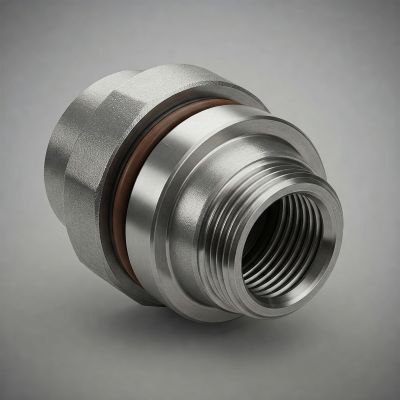In the world of fluid power systems, hydraulic fittings play a critical role in ensuring safe, efficient, and leak-free connections between various components. These small but essential parts are tasked with withstanding high pressure, extreme temperatures, and demanding operational conditions—making durability and leak prevention absolutely crucial.
When it comes to achieving maximum performance and long-lasting reliability, O-ring flat face fittings stand out as a top-tier sealing solution. Their innovative design combines a flat sealing surface with a resilient O-ring, delivering superior performance across a wide range of hydraulic applications.
What Are Flat Face O’Ring Hydraulic Fittings?
O-ring flat face fittings are a type of hydraulic fitting designed to connect tubes or hoses while maintaining a secure, leak-proof seal.
Key Components:
➡️ Flat Face Design: A smooth, machined surface that ensures even contact and alignment.
➡️ Integrated O-Ring Seal: An elastomeric ring housed in a groove on the face of the fitting that provides a soft sealing interface.
These fittings differ from traditional styles such as flare fittings, which rely solely on metal-to-metal contact, or compression fittings, which use ferrules to create a seal. The O-ring flat face fitting offers the best of both worlds—a robust mechanical connection and a flexible, reliable seal.
How Do Flat Face O’Ring Hydraulic Fittings Work?
The design of O-ring flat face fittings incorporates a dual-sealing mechanism:
➡️ A metal-to-metal contact ensures mechanical strength and alignment.
➡️ The O-ring creates a flexible seal that compresses slightly upon installation, preventing leaks, even under high pressure.
This combination not only enhances sealing reliability but also makes the fittings more resistant to vibration, thermal expansion, and repeated connection cycles. The result is a longer-lasting, higher-performing hydraulic connection.
Benefits of Using Flat Face O’Ring Hydraulic Fittings
Leak-Free Connections
O-ring seals are known for their superior ability to prevent leaks, especially in high-pressure hydraulic systems.
Vibration Resistance
The soft seal of the O-ring helps absorb vibration and movement, reducing the chance of loosening or wear over time.
Easy Maintenance
These fittings can be quickly assembled and disassembled without damaging the sealing components—making servicing more efficient.
Corrosion Resistance
Often manufactured using corrosion-resistant materials and coatings, these fittings are built to withstand tough environmental conditions.
Versatile Applications
Compatible with a wide variety of fluids, pressures, and environments, flat face O-ring fittings are suitable for virtually any hydraulic system.
Applications Across Industries
O-ring flat face fittings are used in a wide range of industries where reliability, pressure resistance, and safety are critical:
➡️ Construction and Heavy Equipment – Excavators, loaders, and cranes
➡️ Agriculture and Forestry Machinery – Tractors, harvesters, and sprayers
➡️ Industrial Manufacturing – Hydraulic presses, injection molding machines
➡️ Marine and Offshore Systems – Winches, steering systems, hydraulic lifts
➡️ Aerospace and Defense – Hydraulic flight control systems and ground support equipment
Material Options and Standards
These fittings are available in various materials, including:
➡️ Carbon Steel – Strong and cost-effective
➡️ Stainless Steel – Corrosion-resistant and ideal for harsh environments
➡️ Brass – Used in specific low-pressure or chemical applications
Industry Standards:
➡️ ISO 8434-3 – Covers 24° cone connectors with O-ring face seal ends
➡️ SAE J1453 – Specifies the performance and dimensional standards for O-ring face seal fittings
Choosing the right material ensures compatibility with system pressures, fluids, and environmental conditions.
Installation Tips and Best Practices
To ensure optimal performance and longevity:
➡️ Inspect O-rings before installation for cracks, wear, or damage
➡️ Apply correct torque and alignment during assembly
➡️ Avoid over-tightening, which can deform the O-ring or damage threads
➡️ Perform routine inspections and replace worn O-rings promptly
Common Mistakes to Avoid
Even the best fittings can fail due to improper handling. Watch out for these common errors:
➡️ Reusing damaged or old O-rings
➡️ Mixing materials that aren’t compatible with the hydraulic fluid
➡️ Installing at incorrect angles or using the wrong pressure rating
Choosing the Right Supplier
Selecting a reliable supplier is just as important as choosing the right fitting. Here’s what to look for:
➡️ Certified Products that meet industry standards (ISO, SAE, etc.)
➡️ Technical Support for selection, installation, and troubleshooting
➡️ Wide Selection of sizes, materials, and configurations to match your system
Working with a trusted supplier ensures you get quality products backed by expertise and service.
Conclusion
Flat face O-ring hydraulic fittings are the ultimate sealing solution for modern hydraulic systems. Their combination of leak prevention, vibration resistance, and easy maintenance makes them a smart investment for long-term performance and safety.
Whether you’re operating in construction, agriculture, marine, or aerospace—these fittings provide the reliability your equipment demands.
Post time: May-02-2025


